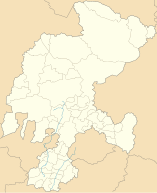Nationalpark Sierra de Órganos
Nationalpark Sierra de Órganos | ||
Felsformationen in der Sierra de Órganos | ||
| Lage | Zacatecas (Bundesstaat), Mexiko | |
| Fläche | 11,25 km² | |
| WDPA-ID | 306848 | |
| Geographische Lage | 23° 47′ N, 103° 48′ W | |
| Einrichtungsdatum | 2000 | |
| Verwaltung | Comisión Nacional de Áreas Naturales Protegidas (CONANP) | |
Der Nationalpark Sierra de Órganos ist einer der jüngsten mexikanischen Nationalparks und umfasst die bizarren Felsformationen der Sierra de Órganos im Bundesstaat Zacatecas mitsamt ihrer Tier- und Pflanzenwelt.
Geographie
Der Park liegt ca. 15 bis 20 km nordwestliche der Stadt Sombrerete im Bundesstaat Zacatecas und weist eine Fläche von 11,25 km² auf.[1] Der Park wurde im Jahr 2000 ausgewiesen.[2]
Literatur
- Mata-Páez, R. I. et al. (2016): Ecological relevance of catclaw (Mimosa spp.) at the Sierra de Órganos National Park. Revista Mexicana de Ciencias Forestales, 7(35), 53–63.Pinar del Rio, Cuba.
Fauna
Wanderfalke (Falco peregrinus)
Schwarzschwanz-Klapperschlange (Crotalus molossus)
Steinadler (Aquila chrysaetos)
Kitfuchs (Vulpes macrotis)
Halsbandpekari (Pecari tajacu)
Rotluchs (Lynx rufus)
Puma (Puma concolor)
Kojote (Canis latrans)
Weblinks
Einzelnachweise
- ↑ visitmexico.com: Explore the natural wonders in Sierra de Organos
- ↑ protectedplanet.net: Sierra de Órganos in Mexico
Auf dieser Seite verwendete Medien
Autor/Urheber: Juan lacruz, Lizenz: CC BY 3.0
Golden Eagle (Aquila chrysaetos) - La Cañada, Ávila, Spain
Autor/Urheber:
|
Collared Peccary, Melbourne Zoo
Autor/Urheber: Kevin Cole from Pacific Coast, USA, Lizenz: CC BY 2.0
Peregrine Falcon Falco peregrinus in flight across Morro Rock in Morro Bay California.
A San Joaquin Kit Fox at the California Living Museum in Bakersfield, Calif. The species was placed on the endangered list on March 11, 1967. Before the Kit Fox inhabited much of California’s San Joaquin Valley prior to 1930. Its range extended from southern Kern County north to eastern Contra Costa County on the Valley’s west side and to Stanislaus County on the east side. By 1930 its range may have been reduced to half, mostly in the southern and western San Joaquin Valley and foothills. The average male San Joaquin kit fox .measures about 32 inches in length (of which 12 inches is the length of its tail). It stands 12 inches high at the shoulder, and weighs about 5 pounds. The female is a little smaller. The San Joaquin kit fox is the smallest canid species in North America (but the largest kit fox subspecies). Photo taken August 20, 1993.
Autor/Urheber: MikSed, Lizenz: CC BY-SA 3.0
Location Map of Zacatecas Equirectangular projection, Geographic limits of the map:
- N: 25.19° N
- S: 21.00° N
- W: 104.40° W
- E: 100.69° W
A coyote communicates with other animals at Rocky Mountain Arsenal National Wildlife Refuge by howling.
Photo Credit: USFWSAutor/Urheber: Summer M. Tribble (daughter of David R. Tribble), Lizenz: CC BY-SA 3.0
Bobcat kittens (Lynx rufus) in North Texas.






















